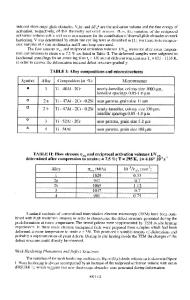Relative stabilities of L1 2 and DO 22 structures in ternary MAl 3 -base aluminides
- PDF / 497,211 Bytes
- 6 Pages / 593.28 x 841.68 pts Page_size
- 8 Downloads / 258 Views
P. J. Meschter McDonnell Douglas Research Laboratories, 224/1111041, P. O. Box 516, St. Louis, Missouri 63166
(Received 21 July 1990; accepted 23 August 1990) The effects of additions of Fe and Zn on the relative stabilities of the cubic Ll 2 and tetragonal DO22 structures in TiAl3- and NbAl3-base alloys are evaluated using ab initio electronic band calculations. The Fe or Zn distribution on the aluminum sublattice is modeled by a periodic array which corresponds to alloying additions of 12.5 or 25 at. % Fe or Zn. Addition of 12.5 at. % Fe is sufficient to stabilize the Ll 2 structure in both TiAl3- and NbAl3-base alloys. Interpolation of the structural energy differences suggests that the DO22 and Ll 2 structures have the same energy at —4.5 at.% Fe in Ti(Al, Fe)3, in agreement with experiment,1'2 and at —11 at.% Fe in Nb(Al,Fe)3. The Ll 2 stabilization effect per atom of Zn in Nb(Al, Zn)3 is approximately half as large as that of Fe. The stable structure is the one for which the Fermi energy lies in a minimum in the density-of-states (DOS) distribution, as in the binary compounds. The results are explained on the basis of a simple model involving charge transfer to alloying additions on the Al sublattice.
I. INTRODUCTION
Transition-metal aluminides such as TiAl3 and NbAl3 are promising materials for high-temperature applications because of their high melting temperatures and low densities. Both TiAl3 and NbAl3 have the low-symmetry tetragonal DO22 crystal structure, deform predominantly by twinning at low temperatures, and fracture at small strains.3'4 Additions to TiAl3 of late transition metals such as Fe, Ni, and Cu, which substitute predominantly for Al, have been shown1'2'5 to stabilize the cubic Ll 2 structure, which has enough equivalent slip systems to allow plastic deformation by slip. Additions of Cr, Mn, Fe, Co, Ni, Zr, Mo, Ag, and W, on the other hand, do not stabilize the Ll 2 structure in an NbAl3-base alloy.6 We have shown by ab initio calculations7 that the calculated total-energy difference between the DO22 and Ll 2 structures, £(DO22) - £(L12), is approximately -0.06 eV/atom (-5800 J/g-atom) for TiAl 3 and -0.20 eV/atom (-19300 J/g-atom) for NbAl3. The value for NbAl3 is in fair agreement with -0.265 eV/atom (-25600 J/g-atom) calculated by Xu and Freeman.8 These results suggest that modification of TiAl3 to the Ll 2 structure by ternary alloying additions should be easier than for NbAl3, simply because the energetic barrier to be overcome is smaller. The stable crystal structure for a given MA13 compound is usually the one in which the Fermi energy lies in a minimum or pseudogap in the electronic density-of-states (DOS) distribution.78 Our purpose in this paper is to determine J. Mater. Res., Vol. 5, No. 12, Dec 1990
http://journals.cambridge.org
Downloaded: 11 Mar 2015
whether the observed differences in Ll 2 stabilization of TiAl3- and NbAl3-base alloys by ternary additions can be justified by ab initio calculations, and to establish the fundamental mechanisms underlying the observed sta
Data Loading...











